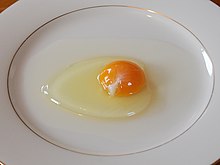**Composition of Egg White:**
– Egg white constitutes around two-thirds of a chicken egg by weight.
– Water makes up about 90% of egg white.
– A raw U.S. large egg contains approximately 33 grams of egg white with 3.6 grams of protein.
– Egg white is an alkaline solution and contains around 149 proteins.
– Major proteins in egg whites include Ovalbumin, Ovotransferrin, Ovomucoid, Ovoglobulin G2, and Ovoglobulin G3.
**Foam Formation and Usage:**
– Beating egg whites creates a foam through denaturation and coagulation.
– Aerated egg whites are used in shaken cocktail recipes for textural and aesthetic purposes.
– When beating egg whites, they form soft, firm, and stiff peaks.
– Copper bowls have been historically used to stabilize egg foams.
– Beaten egg whites do not form correctly if exposed to fats like cooking oils.
**Health Considerations:**
– Egg whites are a source of low-fat, high-protein nutrition but can cause allergies in some individuals.
– Egg allergy is more common in infants than adults.
– Some people may experience food intolerance to egg whites.
– Thorough cooking eliminates Salmonella threat from egg whites.
– Daily consumption of raw egg whites may lead to biotin deficiency due to avidin content.
**Various Uses of Egg White:**
– Egg white is used as a fining agent in wine clarification and stabilization.
– It can create froth in shaken cocktails and is a source of protein in some powders.
– Historically, egg whites were used in early photography and bookbinding.
– Egg whites were believed to prevent swelling and were used for skin care.
– Egg whites are used in gilding processes to give book covers shine.
**Nutritional Value and Culinary Applications:**
– Egg whites are high in protein, low in calories, and fat-free.
– They are rich in vitamins and minerals and contain all essential amino acids.
– Culinary uses include being a binding agent in baking, used for meringues and soufflés, clarifying broths and stocks, adding lightness to dishes, and coating for frying.
– Nutritional benefits include promoting muscle growth and repair, supporting weight loss due to low calorie content, aiding in maintaining healthy cholesterol levels, being a source of choline for brain health, and boosting the immune system with vitamins and minerals.
Egg white is the clear liquid (also called the albumen or the glair/glaire) contained within an egg. In chickens, it is formed from the layers of secretions of the anterior section of the hen's oviduct during the passage of the egg. It forms around fertilized or unfertilized egg yolks. The primary natural purpose of egg white is to protect the yolk and provide additional nutrition for the growth of the embryo (when fertilized). Egg white consists primarily of about 90% water into which about 10% proteins (including albumins, mucoproteins, and globulins) are dissolved. Unlike the yolk, which is high in lipids (fats), egg white contains almost no fat, and carbohydrate content is less than 1%. Egg whites contain about 56% of the protein in the egg. Egg white has many uses in food (e.g. meringue, mousse) as well as many other uses (e.g. in the preparation of vaccines such as those for influenza).

